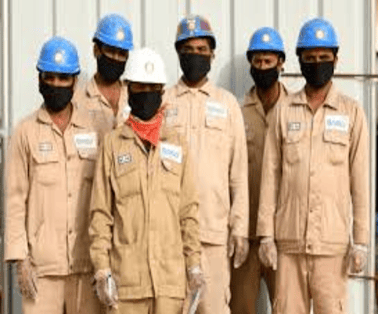The tragic fire disaster in Kuwait, which killed around 50 migrant workers — most of them Indian — has triggered renewed concerns about the safety, rights, and welfare of Indian migrants in Gulf countries. This heartbreaking incident calls for immediate reflection and urgent policy corrections.
The Deep-Rooted Presence of Indian Migrants in Kuwait
- Indians have a significant presence in Kuwait. The Indian rupee was legal tender in Kuwait until 1961.
- Currently, around one million Indian diaspora live in Kuwait, making it the largest diaspora community in the country.
- According to the Indian Embassy, Indians constitute 21% of Kuwait’s total population and 30% of the total workforce.
- The Gulf War in the early 1990s had a significant impact on the Indian population in Kuwait, with over 1.7 lakh Indians returning to India.
- However, the number of Indians going to Kuwait gradually increased after the war.
- The Palestinian community was the largest diaspora community in Kuwait before the Liberation War in 1991, but their numbers declined and were overtaken by Indians.
Indian Migrants in the Gulf: Key Statistics
- The Ministry of External Affairs stated that about 88 million NRIs live in six Gulf nations.
- Specifically, 3.41 million NRIs reside in the United Arab Emirates, 2.59 million in Saudi Arabia, 1.02 million in Kuwait, 0.74 million in Qatar, 0.77 million in Oman, and 0.32 million in Bahrain.
- Indians constitute the largest expatriate community in the GCC nations, making up around 30% of the total expatriate workforce in the region.
- Kerala Migration Survey (KMS) 2023 estimates that 2.2 million people from the state have migrated, with 80% residing in the Gulf Cooperation Council (GCC) countries.
- Off late, Uttar Pradesh and Bihar have begun replacing Kerala, which was a significant contributor of the blue-collar workforce, from India to the Gulf Cooperation Council (GCC) region.
- The migrating workforce primarily consists of individuals aged between 20 and 40, with an increasing participation of women, particularly in the hospitality sector.
- Education levels vary, with many workers having minimal formal schooling or vocational training.
- Around 70% of Indian migrants in the GCC are blue-collar workers, contributing to various sectors in the region.
The Kafala System and the Plight of Indian Migrants
- The Kafala system ties visas to employers, leaving workers reliant on them for housing, food, and transportation.
- Workers often earn insufficient wages, leading to financial insecurity.
- Workers reside in crowded and unsafe accommodations, as seen in the Mangaf fire incident.
- GCC states prohibit labour organizing, depriving workers of the ability to demand better conditions.
- Low-skilled workers face exploitation through withheld pay and inadequate conditions.
- Agents charge high fees and alter contracts, risking passport confiscation.
- Visa restrictions and the kafala system limit migrants’ rights and expose them to deportation threats
Indian Government Initiatives to Protect Migrant Workers
- Emigration Act: The Emigration Act of 1983 provide the legal framework to regulate emigration of Indian workers. It mandates recruitment agencies to register and follow regulations on emigration procedures.
- Bilateral Labour Agreements (BLAs): The government has signed BLAs with several countries to ensure the protection and welfare of Indian migrant workers. These agreements cover aspects like minimum wages, working conditions, repatriation, and dispute resolution.
- Pravasi Bharatiya Bima Yojana (PBBY): This is a mandatory insurance scheme that provides life and disability cover to all Emigration Check Required (ECR) category Indian migrant workers going abroad for employment. It provides coverage of up to Rs. 10 lakh in case of accidental death or permanent disability of Indian migrant workers abroad.
- Minimum Referral Wages (MRW): MRW has been set by the Indian Government for Indian migrant workers abroad in nations that do not have minimum wage laws. It ranges around USD 300 to 600. It is the lowest acceptable salary set by the Indian government for its migrant workers (especially unskilled) going to specific countries.
- eMigrate System: This is an online platform that streamlines the emigration process. It provides pre-departure orientation, registers job contracts, and tracks the status of migrant workers.
- Restrictions on Women’s Emigration: Women below the age of 30 years are not granted emigrant clearance for employment as housemaid, domestic worker, hairdresser, beautician, dancer, stage artist, labourers, or general workers.
Understanding the Gulf Cooperation Council (GCC)
- GCC is a regional organisation comprising 6 nations: Saudi Arabia, the United Arab Emirates, Oman, Kuwait, Qatar, and Bahrain.
- The GCC was established in 1981, with the aim of promoting cooperation, integration, and interconnectivity among its member states, based on their regional and cultural proximity.
- Presently, the primary source of revenue for the GCC countries is derived from the export of oil.
- The GCC member states have been heavily reliant on their oil resources, which have been the backbone of their economies for decades.
- The remittance from Indian emigrants is a very important dimension of the country’s economic development.
- The final figures for total remittances from abroad by NRIs and overall Indians were over $120 billion. India received 28.6% of the total foreign remittances from the GCC. Of this, remittances from Kuwait accounted for 2.4%.
- India was the highest recipient of remittances from abroad in the year 2022. The next remittance receiving countries are: Mexico > China > Philippines > France
Conclusion
The Kuwait fire tragedy is not an isolated incident — it underscores the ongoing struggles and vulnerabilities of Indian migrants in the Gulf. While India’s government has taken several proactive measures, much more is needed to ensure safety, dignity, and fair treatment for Indian workers abroad. A coordinated effort between India and the host nations is essential to prevent further tragedies and uplift the living standards of millions of Indian migrants who fuel economies beyond their homeland.
To Download Monthly Current Affairs PDF Click here
Click here to get a free demo
Discover all about CLAT Exam



